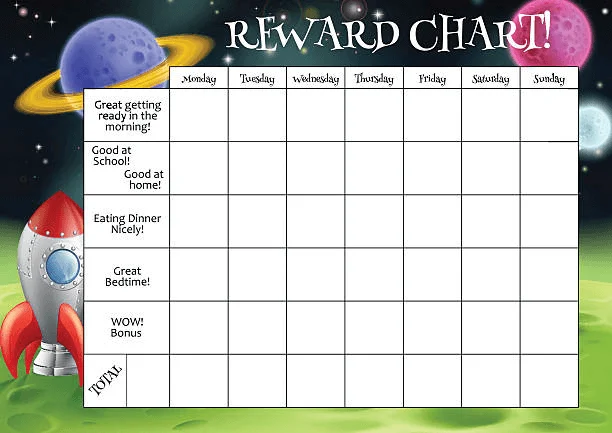If two adults talk about their childhoods long enough, chores always come up.
The shared agony of difficult activities like clearing the table or bringing out the rubbish creates quick and mutual comradery. This common ground is powerful because children are assigned domestic jobs when they can do them responsibly without creating a mess or setting the house on fire.
In today’s child-rearing community, where there are too many tutoring sessions, instrument practices, extracurricular activities, lengthy homework sessions, and after-school events to count, children should benefit long-term from taking time out of other essential activities to do household chores.
Creating a chore chart for the kids is the best way to instill such a responsibility. However, it can be challenging to create the best chart for your kids. That is why we are here to explore some tricks and tips to help you create a successful one for your household.

1. Include a Reward that Motivates your Kids
Chore charts for kids fail most often because your children need to get meaningful enticements. If your kids get something they desire, it is easier to have them do something they do not like.
Parents believe that what motivates them will encourage their kids, too. As a child, you may have liked spending money, so you believe your child does too. This may not be the case. Your kid may be motivated by more computer/tablet/phone time, staying late, getting a new toy, playing more, or borrowing more library books.
Knowing what motivates your child helps you set effective rewards. What your child does in their leisure time or asks for is the best way to find out what matters to them, and we have the form for that.
If your child quits completing tasks after doing them, the reward may no longer motivate them, and you may have discovered their new motivation.
2. Involve your Children

Your kids should help you choose a chore chart. Discussing responsibilities gives them a sense of responsibility and a say in their chores. Speak openly about household contributions as a family. Inform them that chores are life skills and a way to keep the house clean.
Discuss your kids’ interests. Organize things? Enjoy kitchen help? Adjust chores to their preferences. Let them choose tasks that match their interests to boost passion and dedication. Through this involvement, children experience ownership and active participation in establishing a harmonious family.
Chore charting with kids also promotes accountability. Giving youngsters input on their tasks increases the likelihood of them finishing. The family can better grasp each other’s expectations and responsibilities by communicating through this collaborative approach.
It instills teamwork and cooperation in youngsters that transcend domestic tasks and define their lives. Through involvement, you encourage your kids to take responsibility for their obligations, building a sense of independence that will benefit them in the long run.
3. Establishing Clear Consequences in Advance
If the absence of motivating rewards is the main reason chore charts fail, then a lack of predefined consequences takes the blame as culprit number two. Before assigning jobs, explain what happens if they are left unfinished. It is helpful to involve the whole family in setting these consequences. Without specified consequences, unfinished chores can spiral out of control.
Have you ever grounded your child for a week for not making their bed? This may provide a brief sense of fulfillment, but it is neither practical nor proportional. Enforcing a week-long grounding is complex and not proportionate to such an offense.
A 10- or 15-minute earlier bedtime would be a better punishment for bed-making carelessness. This punishment is manageable for parents and unpleasant for the youngster, emphasizing the significance of completing duties.
By setting consequences beforehand, the family maintains a fair and balanced approach and assures suitable repercussions, making the chore chart system more successful and sustainable.
4. Establish Clear Timeframes for Chores
Have you noticed your kids’ resistance increases when you tell them to do something? Everyone dislikes being told what to do, particularly kids. Though well-intentioned, chore charts can feel like an endless stream of instructions for kids. Consider setting a chore deadline to reduce this nagging.
Setting chore deadlines changes everything. By setting a timeline, you give your kids the option to choose how and when to work. This autonomy empowers them to manage their duties. Having a deadline suits both your child’s last-minute heroics and quickness. It makes chores self-motivating and teaches kids time management and responsibility.
Plus, it reduces reminders, creating a more harmonious home and helping your youngster handle their obligations.
5. Use Visual and Interactive Charts
Visual and interactive chore charts make menial work fun for kids. Colorful charts draw their attention and help them understand their responsibilities. Think of a chart with colorful stickers or magnets for completed tasks. It’s enjoyable and rewarding for kids to see their chore chart fill up with accomplished tasks.
Interactive charts instill excitement and responsibility in duty accomplishment. Apps or boards with moving pieces make chores fun for kids. Such charts let children actively track their progress, reinforcing their task completion. They learn responsibility and pride by marking chores with magnets or screens.
These interactive charts allow parents to quickly update assignments, alter duties, and acknowledge achievements, creating a positive and dynamic atmosphere for parents and children. Visual, interactive chore charts make chores fun and teach kids responsibility, turning mundane activities into life lessons.
Bottomline
The article will help shape responsible, confident people by creating the perfect chore chart. Involving kids, setting clear consequences, and infusing creativity with interactive images creates a harmonious home recipe.

Jessi is the creative mind behind The Coffee Mom, a popular blog that combines parenting advice, travel tips, and a love for all things Disney. As a trusted Disney influencer and passionate storyteller, Jessi’s authentic insights and relatable content resonate with readers worldwide.
